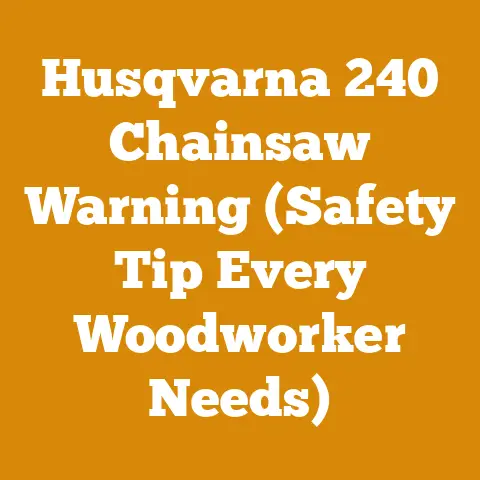Chainsaw Sprocket Wear (5 Key Signs Every Woodcutter Should Know)
The rough bark of an oak log, the smooth, almost polished feel of seasoned cherry, the splintery resistance of pine – these textures tell a story.
They whisper of forests, of seasons, and of the energy waiting to be released as warmth.
As a woodcutter, whether you’re a seasoned pro or just starting to stack your first cord of firewood, you learn to read these textures.
You learn to feel the health of the wood, and, just as importantly, you learn to feel the health of your tools.
And nothing is more crucial to the health of your chainsaw than the sprocket.
The chainsaw sprocket, that little gear-like component nestled behind the clutch, is the unsung hero of woodcutting.
It’s the direct link between the engine’s power and the cutting chain’s relentless bite.
When it’s working flawlessly, you’re slicing through logs like butter.
But when it starts to wear, everything changes.
Performance drops, chains break, and frustration mounts.
That’s why I’ve put together this guide.
I’ve spent years in the woods, learning the hard way about chainsaw maintenance.
I’ve seen firsthand how a neglected sprocket can turn a productive day into a costly headache.
This isn’t just theory; it’s practical knowledge gleaned from countless hours of felling, bucking, and splitting.
I’m going to share with you the five key signs of chainsaw sprocket wear that every woodcutter – from the weekend warrior to the full-time logger – needs to know.
Understanding these signs and taking preventative action can save you time, money, and a whole lot of aggravation.
Before we dive into the nitty-gritty, let’s set the stage with a bit of context about the industry we’re all a part of.
The State of the Wood Processing and Firewood Industry
The global wood processing and firewood industry is a multi-billion dollar behemoth, with trends constantly shifting due to factors like climate change, energy prices, and technological advancements.
Here’s a snapshot of what’s happening:
- Increased Demand for Firewood: With rising energy costs and a renewed interest in sustainable heating, firewood demand is on the rise in many regions.
Data suggests a 15-20% increase in firewood sales in some areas over the past few years (source: various local firewood supplier reports). - Technological Advancements in Logging: The logging industry is becoming increasingly automated, with the use of harvesters, forwarders, and even drones for surveying and planning.
However, the chainsaw remains an indispensable tool, especially for smaller operations and specialized tasks. - Sustainability Concerns: Consumers are becoming more conscious of sustainable forestry practices.
This is driving demand for firewood sourced from responsibly managed forests and for wood processing techniques that minimize waste. - Small-Scale Operations: While large-scale logging dominates the industry, small workshops and independent loggers play a vital role, particularly in supplying local firewood markets.
These smaller operations often face challenges related to access to capital, efficient equipment, and maintaining profitability.
Now, let’s get to the heart of the matter: your chainsaw sprocket.
Chainsaw Sprocket Wear: 5 Key Signs Every Woodcutter Should Know
1. Unusual Chain Wear or Breakage
This is often the first and most obvious sign that something is amiss with your sprocket.
If you’re noticing that your chain is wearing down faster than usual, or if you’re experiencing frequent chain breaks, a worn sprocket could very well be the culprit.
Think of it this way: the sprocket’s teeth are designed to engage with the drive links of the chain in a precise and consistent manner.
When those teeth become worn or damaged, they no longer grip the chain properly.
This can lead to increased friction, uneven wear on the chain, and ultimately, chain breakage.
My Experience: I remember one particularly frustrating autumn where I kept snapping chains on my Stihl MS 261.
I was cutting seasoned oak, nothing too challenging, but I was going through chains at an alarming rate.
I initially blamed the chains themselves, thinking I had gotten a bad batch.
But after the third chain break, I decided to take a closer look at the sprocket.
Sure enough, the teeth were noticeably worn and uneven.
Replacing the sprocket solved the problem instantly, and I haven’t had a chain break since (knock on wood!).
Actionable Steps:
- Inspect the Chain: Carefully examine your chain for signs of wear, such as rounded or flattened drive links, loose rivets, or cracks.
- Check Chain Tension: Ensure that your chain tension is correct.
Too much or too little tension can exacerbate wear on both the chain and the sprocket. - Sharpen Your Chain Regularly: A dull chain puts extra strain on the sprocket, accelerating wear.
- Consider Chain Type: Ensure you are using the correct chain type for the type of wood you are cutting.
Hardwoods require different chains than softwoods. - Replace the Sprocket: If you suspect sprocket wear, don’t hesitate to replace it.
It’s a relatively inexpensive part, and it can save you a lot of money and frustration in the long run.
2. Difficulty Maintaining Chain Tension
A healthy sprocket helps maintain consistent chain tension.
When the sprocket wears down, it can cause the chain to loosen more quickly than normal.
This is because the worn teeth can’t grip the chain properly, allowing it to slip and stretch.
Why It Matters: Constant adjustments to chain tension are not just annoying; they’re also a safety hazard.
A loose chain can derail, causing serious injury.
Furthermore, constantly adjusting the tensioner can wear it out prematurely.
Technical Details: The sprocket’s pitch (the distance between the teeth) is crucial for maintaining proper chain engagement.
When the teeth wear down, the pitch changes, leading to slippage and tension loss.
A difference of even a few millimeters can make a significant impact.
My Observation: I once worked alongside a logger who stubbornly refused to replace his sprocket, despite clear signs of wear.
He spent half his day tightening his chain, and he eventually experienced a catastrophic chain derailment that could have been avoided.
It was a stark reminder of the importance of preventative maintenance.
Practical Advice:
- Monitor Chain Tension Regularly: Check your chain tension every time you refuel your saw.
- Listen for Slippage: Pay attention to the sound of your saw.
If you hear a distinct “clicking” or “slipping” sound, it could be a sign of chain slippage due to a worn sprocket. - Inspect the Tensioner: Make sure the chain tensioner mechanism itself is functioning properly and is not damaged.
- Use a High-Quality Chain: A higher-quality chain will resist stretching and wear better, reducing the strain on the sprocket.
3. Vibration and Unusual Noise
Excessive vibration and unusual noises coming from your chainsaw are often telltale signs of a worn sprocket.
When the sprocket teeth are damaged, they create an uneven surface that causes the chain to vibrate excessively.
This vibration can be felt in your hands and arms, and it can also be heard as a rattling or grinding noise.
The Mechanics of Vibration: A worn sprocket disrupts the smooth, synchronized movement of the chain around the bar.
This creates imbalances that translate into vibration.
The greater the wear on the sprocket, the more pronounced the vibration will be.
Safety First: Excessive vibration can lead to fatigue and even long-term health problems, such as Hand-Arm Vibration Syndrome (HAVS).
It’s crucial to address vibration issues promptly to protect your health and well-being.
My Personal Story: I initially dismissed the increased vibration in my chainsaw as just part of the normal wear and tear.
However, after a particularly long day of cutting, my hands were numb and tingling.
I realized that the vibration was more than just a nuisance; it was a potential health hazard.
I immediately replaced the sprocket, and the vibration disappeared.
Troubleshooting Tips:
- Check for Loose Components: Before assuming that the sprocket is the culprit, check for other loose components, such as the bar, clutch, or muffler.
- Inspect the Bar: A bent or damaged bar can also cause vibration.
- Listen Carefully: Pay close attention to the type of noise your saw is making.
A grinding noise is often indicative of metal-on-metal contact, which can be caused by a worn sprocket. - Use Anti-Vibration Gloves: Wearing anti-vibration gloves can help reduce the impact of vibration on your hands and arms.
- Limit Exposure: Take frequent breaks to reduce your exposure to vibration.
4. Visible Wear and Damage to the Sprocket Teeth
This is the most direct and obvious sign of sprocket wear.
A healthy sprocket should have sharp, evenly spaced teeth.
When the teeth become rounded, flattened, chipped, or broken, it’s a clear indication that the sprocket needs to be replaced.
Types of Wear:
- Rounding: The sharp edges of the teeth become rounded off due to friction.
- Flattening: The tips of the teeth become flattened, reducing their ability to grip the chain.
- Chipping: Pieces of the teeth break off, creating an uneven surface.
- Breaking: Entire teeth can break off, rendering the sprocket unusable.
The Importance of Inspection: Regular visual inspection of the sprocket is crucial for detecting wear and damage early on.
I recommend inspecting your sprocket every time you change your chain.
My Method: I use a small magnifying glass to get a close-up view of the sprocket teeth.
This allows me to spot even minor wear and damage that might otherwise go unnoticed.
Detailed Inspection Steps:
- Remove the Chain and Bar: This will give you a clear view of the sprocket.
- Clean the Sprocket: Use a wire brush to remove any dirt or debris.
- Inspect the Teeth: Carefully examine each tooth for signs of rounding, flattening, chipping, or breaking.
- Check for Cracks: Look for any cracks in the sprocket body.
- Compare to a New Sprocket: If possible, compare your sprocket to a new one to get a better sense of the extent of the wear.
5. Difficulty Starting or Stalling
While not always directly related to the sprocket, difficulty starting your chainsaw or frequent stalling can sometimes be a symptom of a worn sprocket, especially in conjunction with other signs mentioned above.
A severely worn sprocket can create excessive drag on the chain, making it harder for the engine to turn over.
The Link Between Sprocket and Engine Performance: A worn sprocket increases the overall load on the engine.
The engine has to work harder to overcome the friction and resistance caused by the damaged sprocket teeth.
This can lead to reduced engine performance, including difficulty starting and stalling.
Other Potential Causes: It’s important to rule out other potential causes of starting and stalling issues, such as a dirty air filter, a clogged fuel filter, a faulty spark plug, or a carburetor problem.
My Troubleshooting Process:
- Check the Basics: Start by checking the air filter, fuel filter, and spark plug.
- Clean the Carburetor: If the filters are clean, try cleaning the carburetor.
- Inspect the Sprocket: If the problem persists, inspect the sprocket for wear and damage.
- Consider the Clutch: A worn clutch can also cause similar symptoms.
Case Study: A local firewood producer was struggling with a chainsaw that kept stalling.
He had already replaced the spark plug and cleaned the carburetor, but the problem persisted.
He finally brought the saw to me, and I quickly identified a severely worn sprocket.
Replacing the sprocket solved the stalling issue immediately.
Additional Considerations: Choosing the Right Sprocket and Maintenance Tips
Types of Chainsaw Sprockets
There are generally two main types of chainsaw sprockets:
- Spur Sprockets: These are one-piece sprockets that are typically found on smaller, less expensive chainsaws.
They are simple and relatively inexpensive to replace, but they tend to wear out faster than rim sprockets. - Rim Sprockets: These sprockets consist of a separate rim that is replaceable.
The rim sits on a splined hub that is attached to the clutch.
Rim sprockets are more durable and offer better chain alignment, but they are also more expensive.
Choosing the Right Type: The best type of sprocket for your chainsaw depends on your needs and budget.
If you’re a casual user, a spur sprocket may be sufficient.
However, if you’re a professional or a frequent user, a rim sprocket is a better investment.
Maintenance Tips for Extending Sprocket Life
- Keep Your Chain Sharp: A dull chain puts extra strain on the sprocket, accelerating wear.
Sharpen your chain regularly, or replace it when necessary. - Maintain Proper Chain Tension: Too much or too little chain tension can damage the sprocket.
Adjust the tension regularly according to the manufacturer’s recommendations. - Lubricate Your Chain Properly: Proper chain lubrication reduces friction and wear on both the chain and the sprocket.
Use a high-quality bar and chain oil. - Clean Your Chainsaw Regularly: Remove dirt, debris, and sawdust from your chainsaw after each use.
This will help prevent wear and damage to the sprocket and other components. - Store Your Chainsaw Properly: Store your chainsaw in a dry, protected location when not in use.
This will help prevent rust and corrosion. - Use the Right Chain for the Job: Using the wrong type of chain for the type of wood you’re cutting can accelerate wear on the sprocket.
Costs and Budgeting
Replacing a chainsaw sprocket is a relatively inexpensive repair.
Spur sprockets typically cost between \$10 and \$20, while rim sprockets can cost between \$20 and \$50.
The cost of labor for replacing the sprocket can vary depending on the repair shop and the complexity of the job.
Budgeting Tip: I recommend setting aside a small amount of money each year for chainsaw maintenance.
This will help you avoid unexpected repair costs and keep your saw running smoothly.
Common Pitfalls and Troubleshooting
- Ignoring the Signs: The most common pitfall is ignoring the signs of sprocket wear until it’s too late.
Don’t wait until your chain breaks or your saw stalls to inspect your sprocket. - Using the Wrong Parts: Make sure you’re using the correct replacement sprocket for your chainsaw model.
Using the wrong parts can damage your saw and void your warranty. - Improper Installation: Improper installation of the sprocket can lead to premature wear and damage.
If you’re not comfortable replacing the sprocket yourself, take it to a qualified repair shop. - Over-Tightening: Avoid over-tightening the clutch nut when installing the sprocket.
Over-tightening can damage the clutch and the sprocket.
Next Steps and Additional Resources
Now that you know the key signs of chainsaw sprocket wear, you can take proactive steps to maintain your saw and prevent costly repairs.
Here are some additional resources that you may find helpful:
- Chainsaw Manufacturer Websites: Most chainsaw manufacturers have websites with detailed information about their products, including maintenance tips and troubleshooting guides.
- Online Forums and Communities: There are many online forums and communities dedicated to chainsaws and woodcutting.
These forums are a great place to ask questions, share tips, and learn from other enthusiasts. - Local Chainsaw Repair Shops: If you’re not comfortable performing chainsaw repairs yourself, take your saw to a qualified repair shop.
- Suppliers of Logging Tools:
- Bailey’s: A well-known supplier of logging tools and equipment.
- Northern Tool + Equipment: A retailer offering a wide range of tools, including chainsaws and accessories.
- Forestry Suppliers, Inc.: A supplier specializing in forestry and logging equipment.
- Drying Equipment Rental Services:
- Sunbelt Rentals: Offers a variety of equipment rentals, including drying equipment.
- United Rentals: Another major equipment rental company with drying solutions.
Parting Thoughts: A Woodcutter’s Wisdom
The chainsaw is more than just a tool; it’s an extension of your skill and your connection to the forest.
By understanding the inner workings of your saw, including the crucial role of the sprocket, you can ensure its longevity and maximize its performance.
Remember, a well-maintained chainsaw is a safe chainsaw, and a safe chainsaw is essential for a productive and enjoyable woodcutting experience.
So, keep your chains sharp, your sprockets healthy, and your focus on the task at hand.
Happy cutting!






